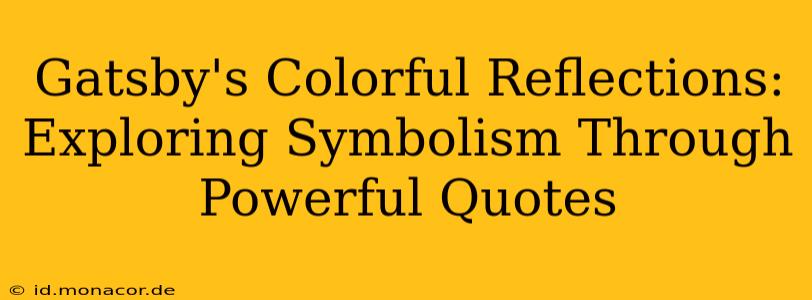F. Scott Fitzgerald's The Great Gatsby isn't just a captivating love story; it's a vibrant tapestry woven with potent symbols that reflect the Roaring Twenties and the human condition. Through evocative imagery and carefully chosen words, Fitzgerald paints a picture of wealth, loss, and the elusive American Dream. Let's delve into some powerful quotes, exploring their symbolism and the deeper meanings they unveil.
What is the significance of the green light in The Great Gatsby?
The green light at the end of Daisy Buchanan's dock is arguably the most iconic symbol in the novel. It represents Gatsby's yearning for the past, his idealized vision of his relationship with Daisy, and the unattainable nature of his dream. It's a beacon of hope, constantly shimmering just out of reach, mirroring the futility of his pursuit. The green light is not merely a light; it's the embodiment of Gatsby's longing, his relentless hope, and ultimately, his tragic flaw. Its shimmering, almost ethereal quality underscores the illusionary nature of his dream.
What does the color gold symbolize in The Great Gatsby?
Gold in The Great Gatsby is inextricably linked to wealth, extravagance, and superficiality. Gatsby's opulent parties, his lavish mansion, and his ostentatious displays of wealth are all rendered in shades of gold, representing the superficiality of the Jazz Age elite. However, the gold isn't simply celebratory; it hints at a hollowness beneath the glittering surface. The gold represents the emptiness that accompanies the relentless pursuit of wealth without genuine connection or purpose. It is a deceptive shimmer, masking the underlying anxieties and moral decay.
What are the important symbols in The Great Gatsby?
Beyond the green light and gold, several other symbols contribute to the novel's rich tapestry. The Valley of Ashes, a desolate wasteland between West Egg and New York City, symbolizes the moral and social decay hidden beneath the glittering façade of wealth. The eyes of Doctor T.J. Eckleburg, overlooking the Valley of Ashes, are often interpreted as a symbol of God's judgment or the ever-watchful gaze of morality. Furthermore, cars, with their speed and power, represent the reckless abandon and dangerous pursuit of pleasure prevalent in the era. Each symbol contributes to a multi-layered interpretation of the novel’s themes.
How does Fitzgerald use symbolism in The Great Gatsby?
Fitzgerald masterfully employs symbolism to enhance the narrative's emotional impact and thematic depth. He doesn't explicitly define the meaning of these symbols, allowing readers to engage with them on multiple levels. The ambiguity inherent in his symbolism forces readers to contemplate the complexities of the characters and the societal issues he addresses. The evocative nature of his language and the carefully chosen imagery work together to create a powerful and lasting impression on the reader, long after finishing the book. His symbolism transcends the mere representation of objects; it delves into the psychological and emotional landscapes of his characters and their era.
What are some of the most important quotes from The Great Gatsby?
Many quotes in The Great Gatsby resonate with symbolic weight. For instance, "So we beat on, boats against the current, borne back ceaselessly into the past," encapsulates Gatsby's futile struggle to recapture the past. This quote speaks to the human tendency to cling to memories and idealized versions of the past, highlighting the power of nostalgia and its limitations. Another poignant quote is Daisy's statement, "That's the best thing a girl can be in this world, a beautiful little fool," which reveals the societal constraints placed on women and the superficiality of the era’s values.
Conclusion: The Enduring Power of Symbolism
Through carefully constructed symbolism, Fitzgerald creates a timeless masterpiece. The enduring power of The Great Gatsby lies in its ability to evoke emotions and spark intellectual discourse long after the last page is turned. By exploring the symbolic language embedded within the novel, we gain a deeper understanding of its themes, characters, and the complexities of the human condition. The enduring appeal of Gatsby's colorful reflections lies in their ability to resonate with readers across generations, prompting continued analysis and interpretation.

